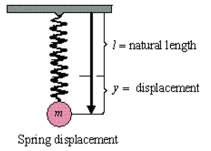Multiple Choice
Find the particular solution of the differential equation for the oscillating motion of an object on the end of a spring. In the equation, is the displacement from equilibrium (positive direction is downward) measured in feet, and is the time in seconds (see figure) . The constant is the weight of the object, is the acceleration due to gravity, is the magnitude of the resistance to the motion, is the spring constant from Hooke's Law, is the acceleration imposed on the system, and 
A)
B)
C)
D)
E)
Correct Answer:

Verified
Correct Answer:
Verified
Q22: Taylor's Theorem to find the first
Q23: Solve the differential equation <span
Q24: Find the general solution of the
Q25: Use Taylor's Theorem to find the
Q26: <span class="ql-formula" data-value="\text { Find the general
Q28: Find the particular solution of the
Q29: Solve the differential equation <span
Q30: Use Taylor's Theorem to find the
Q31: Using the method of undetermined coefficients,
Q32: Suppose a 32-pound weight is suspended